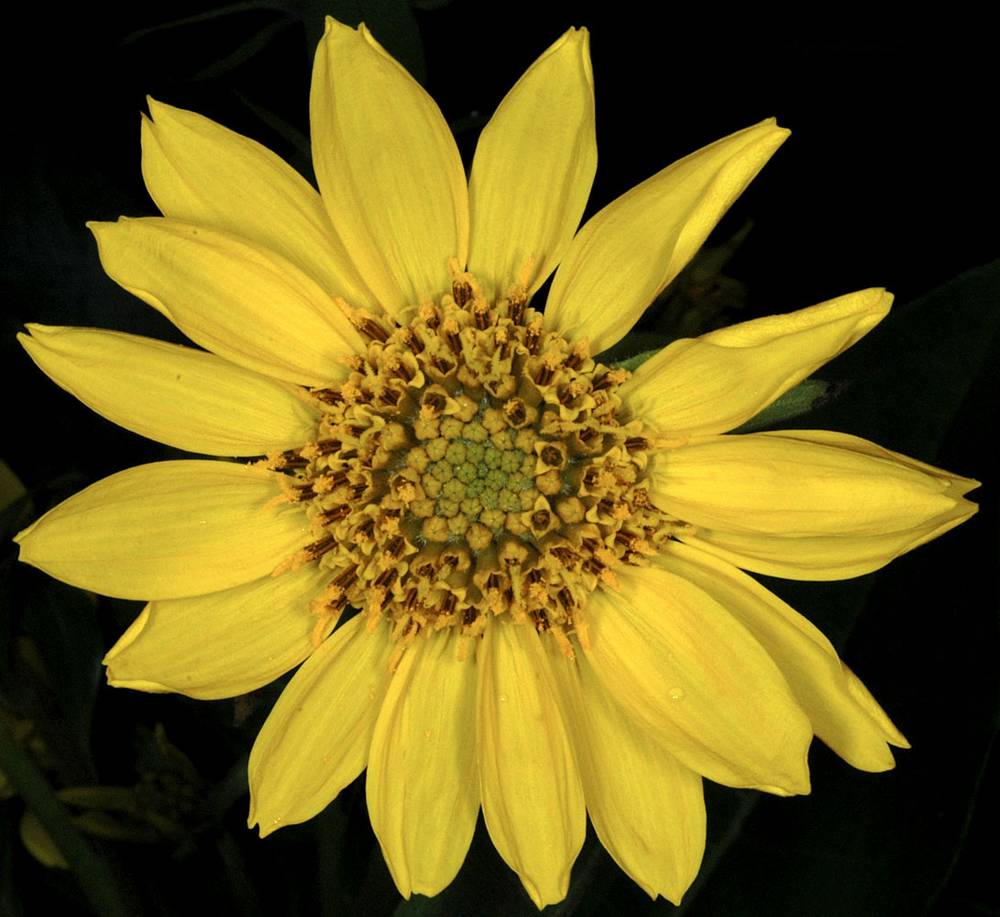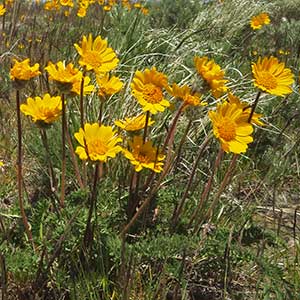Balsamorhiza deltoidea
Balsamorhiza hookeri
deltoid balsamroot
Hooker's balsamroot
forming clumps, 14–54 cm, green, villous-hirsute, with shorter, glandular hairs.
11–47 cm; hirsute; from single taproot.
simple;
margins entire to toothed;
teeth rounded and apiculate;
surfaces abaxially sparsely hirsute, adaxially sparsely hirsute, villous-hirsute on veins;
basal leaves in multiple rosettes;
blades deltate, 7.5–27 × 6–16 cm, bases cordate or hastate;
petioles 10–27 cm;
cauline blades 3–7.5 × 1.1–2.7 cm;
petioles 0–8.5 cm.
lanceolate to ovate-lanceolate, 1-pinnately divided with some pinnae toothed or lobed to 3-pinnately lobed;
margins entire to crenate or serrate;
surfaces hirsute to hirsute-sericeous;
basal leaves in 1–few rosettes;
blades 12–24 × 4–12 cm;
pinnae 1–10 mm wide;
petioles 4–15 cm;
cauline blades 3–14.5 × 0.6–4 cm;
petioles 4–11 cm.
with 1 larger; terminal head and 0–2 smaller; axillary heads;
peduncles 1–12 cm.
with 1 terminal head.
terminal 10–15 × 20–33 mm; axillary 8–10 × 11–17 mm.
8–15 × 15–25 mm.
deciduous, 11–21 on large heads, 6–9 on small heads, yellow;
rays 18–35 × 4–17 mm.
deciduous, 10–17, yellow;
rays 15–30 × 4–7 mm.
5–8 mm.
~6 mm.
ovate, 10–32 × 4–9 mm, villous; more densely so at bases; outer phyllaries often lanceolate; longer than inner.
linear-lanceolate to ovate, 13–20 × 3–6 mm, with or without long-acuminate tips, villous-hirsute and ciliate, sometimes glabrous proximally.
9 × 1.5 mm, glabrous.
6.5 × 1.5 mm, glabrous.
~7 mm.
11–12 mm.
=38.
=38.
Balsamorhiza deltoidea
Balsamorhiza hookeri
Grasslands, pine or oak woodlands. Flowering Mar–Jul. 50–2200 m. Casc, ECas, Sisk, WV. CA, WA; north to British Columbia. Native.
Balsamorhiza deltoidea grows west of the Cascade Range and intergrades with B. careyana in the Cascades and along the Columbia River. (See discussion under B. careyana.) It also hybridizes with B. sericea in Josephine County. Hybrids between Balsamorhiza deltoidea and B. hookeri have been given the name B. × terebinthacea but are not expected to be found in Oregon, given that the ranges of the parental species do not overlap here. The specific epithet refers to the deltoid shape of the leaves.
Dry, open, often rocky areas. Flowering Apr–Jun. 1000–1600 m. BR, BW. CA, ID, NV, WA; southeast to UT. Native.
As treated here, B. hookeri consists of the members of section Balsamorhiza that are left over after the entities that are distinct in at least some parts of their ranges are removed. Balsamorhiza hookeri hybridizes with B. hispidula and B. sagittata. The species is named after the British botanist William Jackson Hooker, who initially described it as Heliopsis balsamorhiza and tentatively proposed (but did not validly publish, as he did not accept it) the genus Balsamorhiza under the supposition that it would prove to be distinct from Heliopsis once better material was collected.
Abigail (Abby) Moore
Abigail (Abby) Moore
- Local floras:
BC,
CA,
OR,
WA
- Local Web sites:
CalFlora,
CalPhotos,
Flora NW,
PNW Herbaria,
Turner Photog.
WildflowerSearch
iNaturalist (observations)
USDA Plants Database
- LBJ Wildflower Center
- SEINet
- Plants of the World Online
- Encyclopedia of Life
- Wikipedia
- Google Image Search





